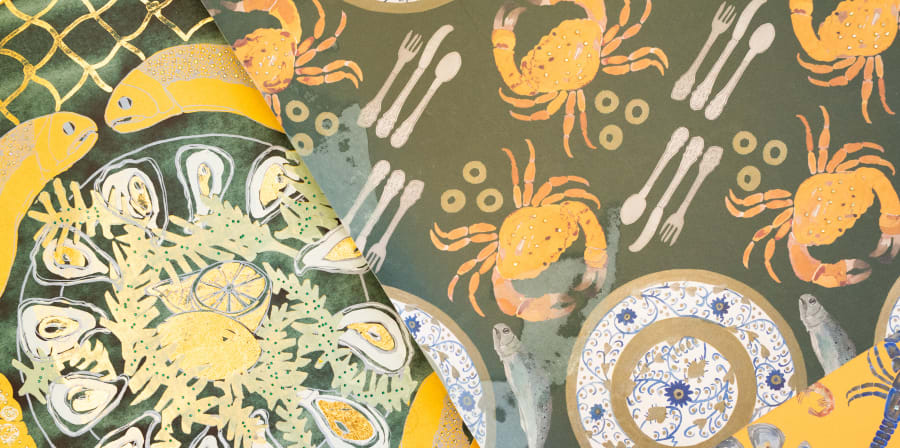
Some of the 165 students who took part in our student project explain the inspirations, techniques and science behind their conscious designs.
- 6 Out of 100, Mizuki Tochigi (BA Jewellery)
Using discarded heels to raise awareness of gender inequality
- Crystals Without Colourants, Brigitte Kock (MA Material Futures)
Exploring structural colour as a replacement for harmful dyes
- Slow Fashion, Niamh O'Sullivan (BA Jewellery)
Creating an app for rental of consciously designed jewellery
- Future Heirlooms, Nicole Pinborough (BA Textiles: Knit)
Exploring gender inequality through traditional craft
- Algae for Clean Air, Sarah Graham (MA Material Futures)
Utilising the air purifications properties of algae to improve sleep patterns
- Li-Fi Beacon, Elizabeth Harper (MA Material Futures)
Using a refractive crystal shade to beam music wirelessly via LED
- Rip It Up and Start Again, Yasmin Everley (BA Jewelley)
Crystals captured in ice settings
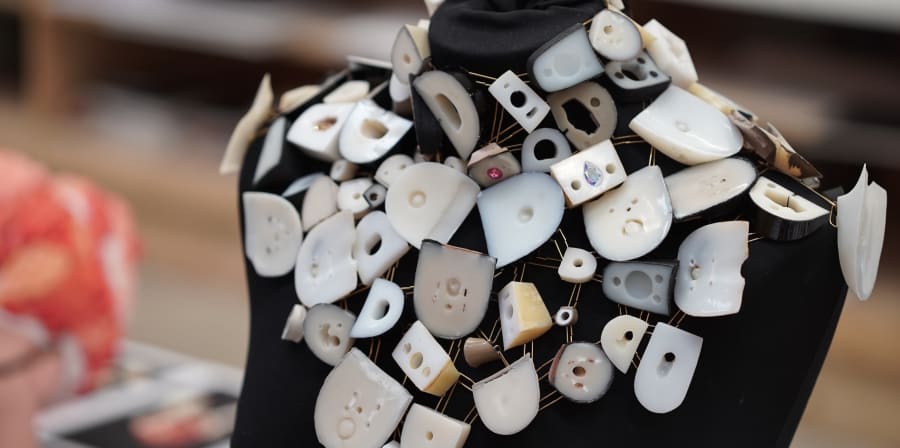
6 out of 100 - Mizuki Tochigi
What’s the inspiration behind your project?
I wanted to very clearly visualise gender inequality. Even in the UK, which seems to have a very small gender gap, there is deep-rooted gender inequality. Whilst looking for a waste material that could communicate the gender issue I came across heels. High-heeled shoes are not comfortable but women still wear them because they are expected to be worn in a business setting, making women as tall as men and perhaps making them feel good.
My work is made of 100 pieces of broken heel parts, six of which have a Swarovski crystal embedded in the centre. These six represent the fact that there were only six female CEOs among the top 100 UK companies in 2019. The broken heels without a crystal represent women who were not promoted - something which may not have happened if they were men. The hollowness represents the emptiness of women’s feelings.
I want my work to highlight how few female CEOs were in the top 100 companies in 2019 and to encourage people to think about the gender inequality issue.
As a designer would you say you’re consciously minded or do you put more emphasis on the creative process?
I would say I am consciously minded - it is because I am Japanese. We are taught not to cut and glue paper when we create origami so that we can unfold the paper to use again. This creates less waste, uses less glue and lets us appreciate the original shape of the paper. That basic idea of not using glue and appreciating a material's original form and colour is the foundation of my design.
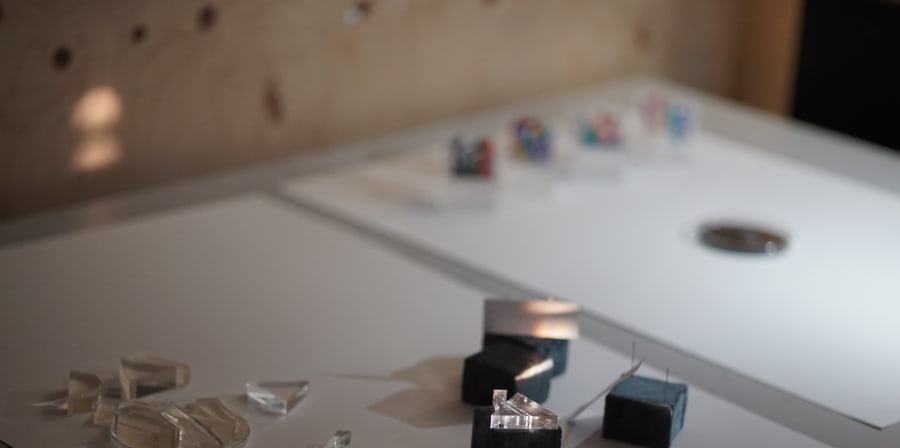
Crystals Without Colourants - Brigitte Kock
What’s the inspiration behind your project?
I started this project with an interest in structural colour: a mechanism in nature that utilises light to colour the world around us in a special way. Rather than pigment, transparent nanocrystals within the scales, skin or feathers of certain animals selectively reflect only certain wavelengths of light. This means that we may perceive a bird as green when in fact its feathers have no pigment.
For me, the ultimate goal would be to replace dyes and the chemicals involved in pigmenting materials with a coating of nano-structures. Also making this out of a renewable, natural material (e.g. chitin) would be a farfetched yet amazing challenge.
Since I wasn't be able to work with nano-scaled structures in my project I planned to scale up the nanocrystals to a workable crystal size. My aim was to shine white light in the crystal and only get the blue wavelengths reflecting back.
As a designer would you say you’re consciously minded or do you put more emphasis on the creative process?
I think both go hand in hand. If you are too focussed on a goal (e.g. sustainability) you will not be able to think outside the box much, yet if you only think about the creative process you will not end up with a sustainable product. So, knowing when to focus on which one and when to implement them during the process is key.
What is your creative process, do you usually have a vague idea in mind and work towards that or do you just let your creative research guide you?
I prefer to have a vague idea in mind, a vision or societal issue to work with, but if the process changes that initial direction I’ll let it happen.
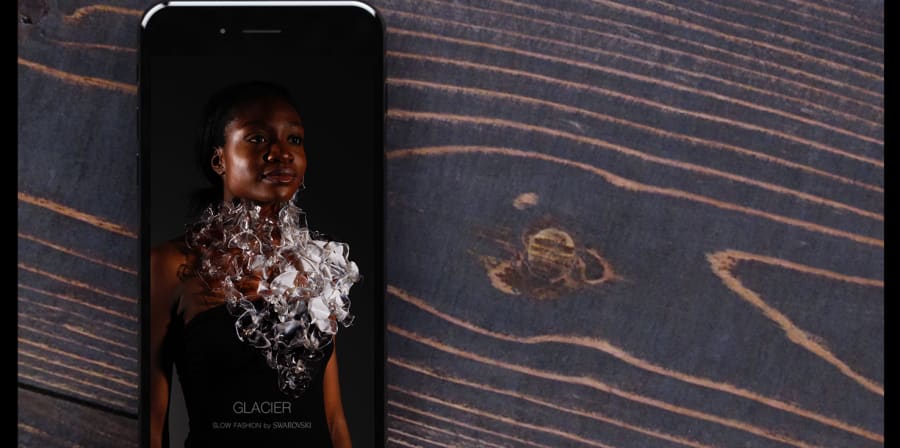
Slow Fashion - Niamh O'Sullivan
What’s the inspiration behind your project?
“Its not about a few people being perfectly sustainable, it's about the majority of people doing it imperfectly”.
My project was inspired by this quote and took the form of a proposal for an app that would be used as a platform to rent and buy second hand jewellery. This could at once suppress demand for new jewellery and support the utilisation and recycling of existing pieces. I also designed and created a piece of jewellery as an example of the type of product the app could promote. Taking inspiration from both our planet's natural beauty and environments that are under threat as a result of human activity, I created a large chest piece from single-use plastic and Swarovski crystals. The piece was inspired by icebergs and rainforest canopies, these beautiful landscapes would also be inspiration for content on the app's launch screen.
What does conscious design mean to you?
Conscious design means considering the environmental impact in my design process. I try to think about the manufacturing of the piece and the material it is made from in addition to what I want the work to say. I continually try to predict and minimise the impact the creation process will have on the environment.
I like to make social comments through my work and therefore conscious design is a big part of my thought process. I think about how people will read the work and whether it will in some way cause them to consider the effects that humans are having on the world. I hope to make people more aware of alternative, more sustainable design methods.
What is your creative process, do you usually have a vague idea in mind and work towards that or do you just let your creative research guide you?
My process can vary depending on the project. In some cases, I will have an idea of how I would like the piece to turn out from the beginning, and I will then work through research and development to inform that outcome. However, most of the time I will let the project go where it naturally takes me. More often than not I will quickly become very interested in a facet of my research and immerse myself in it, researching it heavily until I feel comfortable that I have got to grips with the information I'm looking at. I would then usually consider what I want the piece to say, begin to develop a visual language and explore how I can translate this in my work.
How was it working with Swarovski crystals? Is it a material you have worked with before?
I loved working with the Swarovski crystals. I loved the freedom we had and the fact we could choose from such an extensive range. I felt like I could do a lot with the crystals and wanted to experiment with them in non-traditional ways.
What I found amazing was how the crystals could elevate the material they were combined with. I was working with single use plastic food packaging which ordinarily would end up in a landfill, however through manipulating the material and setting crystals within it I found that I could make the plastic look expensive and precious. I think that this was one of the most liberating things about working with the crystals - I felt like I had real autonomy with my designs because, with the addition of the crystals, the work was enhanced and felt effortlessly luxurious despite the fact it was made from cheap plastic.
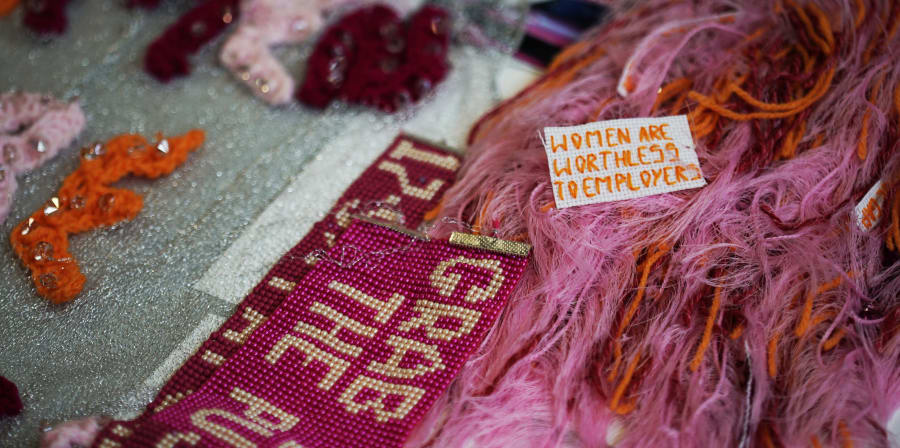
Nicole Pinborough - Future Heirlooms
What’s the inspiration behind your project?
My project focused on the sexism women still face today. I was inspired by the suffragettes, their placards and slogans, and how feminism has evolved in the past century. I drew parallels between quotes from modern day misogynists, the reality of sexual violence and the gender pay gap for women in the UK. I aimed to create accessories which could act as contemporary placards protesting the patriarchy, with the idea that a fairer society would be passed down through the generations. Traditional handicrafts, which are typically seen as feminine pursuits, inspired the process and techniques used in my project; the slogans I was writing giving a new power to old crafts.
As a designer would you say you’re consciously minded or do you put more emphasis on the creative process?
I think as a designer it is our responsibility to be consciously minded. Real change needs to be made in the way we produce, use, and dispose of products and designers have the power to do that. The creative process still applies to conscious design, if anything it makes it more interesting. Setting yourself limitations can force you to experiment more; I used no new materials during this project, recycling old yarns and waste materials alongside the upcycled crystals.
How was it working with Swarovski crystals? Is it a material you have worked with before?
I had never worked with Swarovski crystals before and I was amazed at the sheer variety we had to choose from. I enjoyed trapping them in bubble wrap and other plastic waste, creating a sharp contrast between the delicacy and beauty of the crystals and the mundanity of the rubbish.
I had never worked with Swarovski crystals before and I was amazed at the sheer variety we had to work with. I enjoyed trapping them in bubble wrap and other plastic waste, creating a sharp contrast between the delicacy and beauty of the crystals and the mundanity of the rubbish.
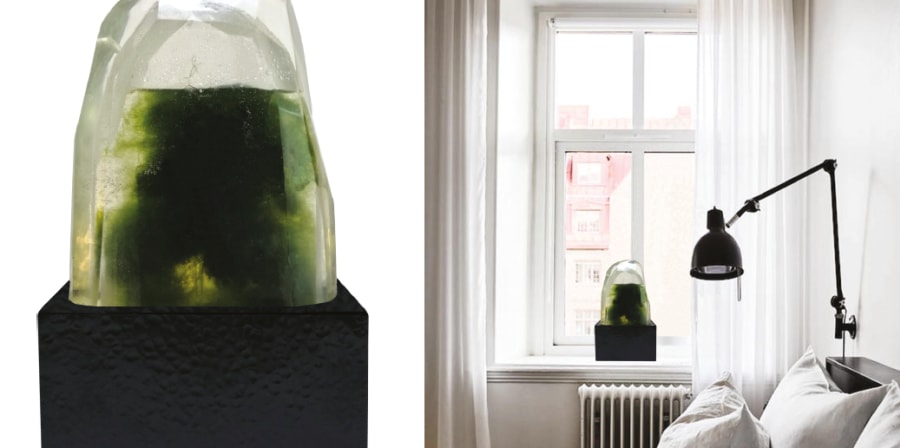
Algae for Clean Air - Sarah Graham
What’s the inspiration behind your project?
Algae for Clean Air is about exploring the properties of algae and democratising bio-design technologies. Although I expressed this in a luxury product for Swarovski, my initial draw to working with algae was that it is a highly accessible material. Algae is found all over the world and has the potential for clean energy production and air purification.
As a designer would you say you’re consciously minded or do you put more emphasis on the creative process?
My goals are to educate, provoke discussion and to provide people seeking positive change with alternative designs.
How was it working with Swarovski crystals? Is it a material you have worked with before?
I have used Swarovski crystals for fashion before, but this was a unique experience designing with crystal as a material. It was exciting to probe the technical capabilities of crystal as a material and the cutting expertise of Swarovski. I found the contrast interesting between the high-tech crystal material versus the algae I scooped up from the canal.
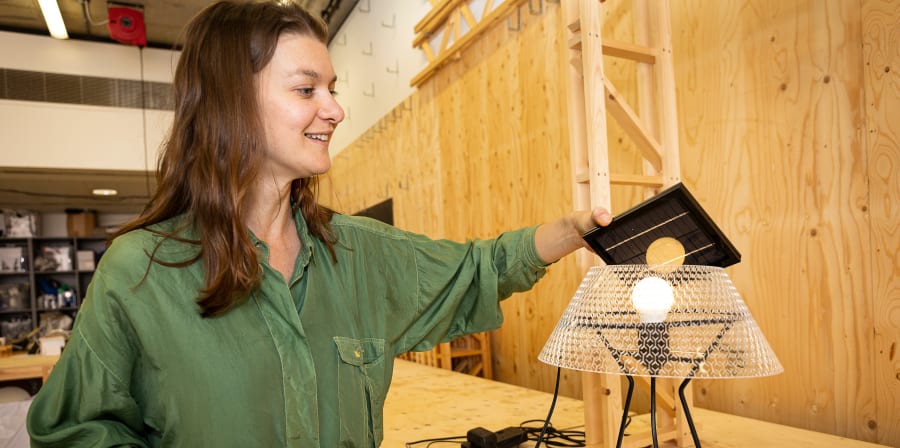
Li-Fi Beacon - Elizabeth Harper
What’s the inspiration behind your project?
I was inspired by current public debate about the pros and cons of 5G, wireless and EMF (electromagnetic field) communications generally. As I researched the history of how wireless has progressed - from its 1G origins to today’s transition from 4G to 5G - I was completely struck by the possibility of using visible light for transmitting information. For my final piece I drew on research by Professor Harald Haas and his concept of Li-Fi (light fidelity).
What does conscious design mean to you?
A deep understanding of materials, tools and processes. This includes an awareness of the so-called ‘triple bottom line’ and how people, planet and profit all intersect. Conscious design to me means embracing the complexity of our situation today - accepting that there is not going to be one simple ‘sustainable’ answer that ticks every box in every context.
What is your creative process, do you usually have a vague idea in mind and work towards that or do you just let your creative research guide you?
Everything is research. In the news, on the street, in the galleries and out in the weather. I keep long lists of ideas and questions simmering in the back of my mind. The way things combine can be magical when I am in a flow of experimentation. The main thing is having enough time and space for that, which is why it’s so great to be a student!
Rip It Up and Start Again - Yasmin Everley
What’s the inspiration behind your project?
Sustainability was one of the directives given to us and became the main source of inspiration for my project. I interpreted sustainability as the conservation of balance by avoiding the depletion of natural resources. I created a video piece where Swarovski crystals are captured in ice in classic jewellery forms. The piece is in a continual state of flux - a microcosm of the water cycle - where the setting melts away to leave the crystals undamaged and ready to be poured into a new piece. Crystals become the point of consistency within the ebb and flow of the forms around them.
As a designer would you say you’re consciously minded or do you put more emphasis on the creative process?
As a designer I would say that I am growing. The more that I learn about the environments and communities that are affected by every decision we make as consumers, the more I realise I have to learn. There is often no easy answer as changes in consumer behaviour to be more environmentally friendly can take a livelihood away from another group and vice versa, so the main thing is to educate ourselves.
What is your creative process, do you usually have a vague idea in mind and work towards that or do you just let your creative research guide you?
I tend to over-research and have a dozen ideas bubbling away at once without taking care to refine or cultivate any of them. Eventually one idea will rise to the surface and I have to try to focus in on that one and let the others fall away.